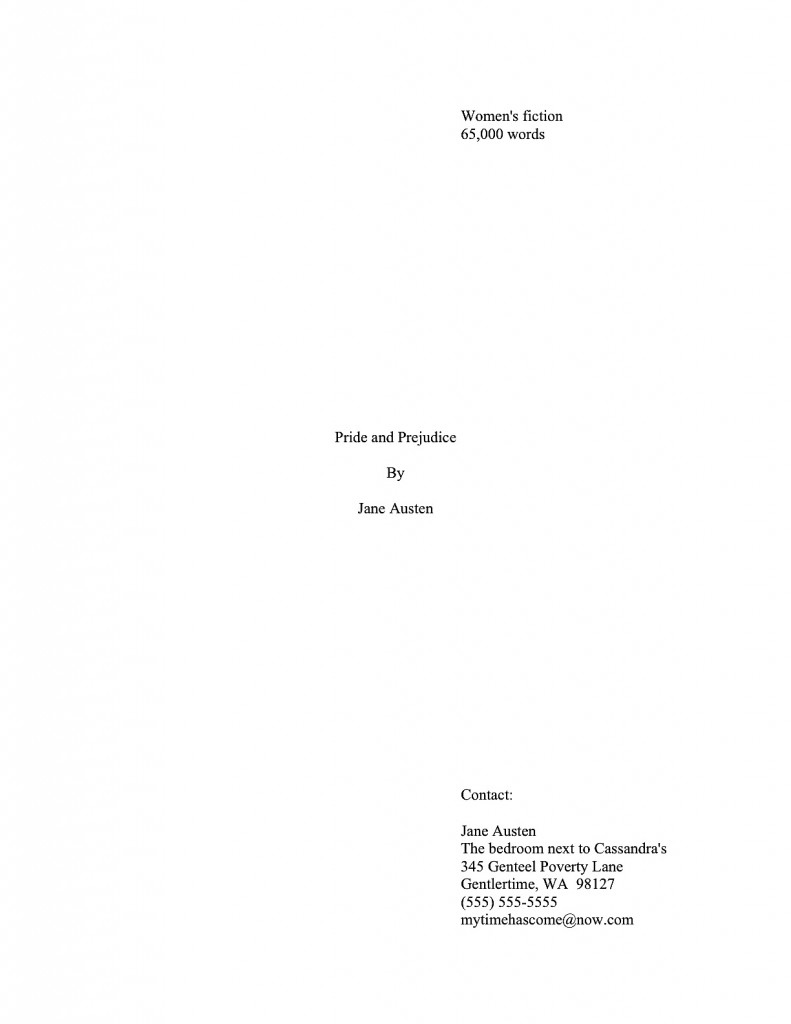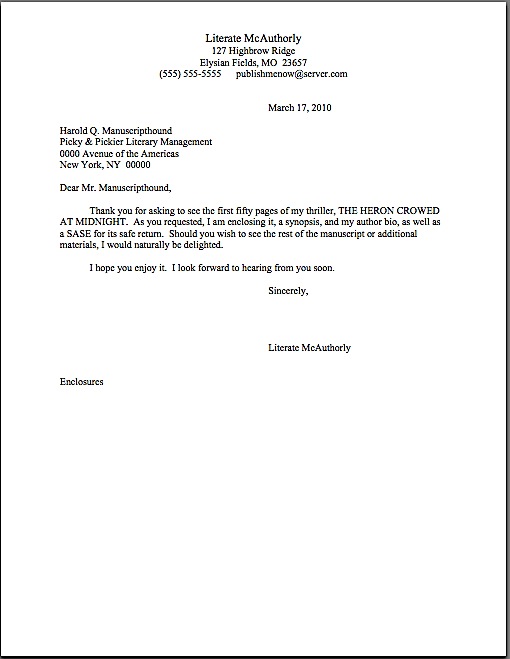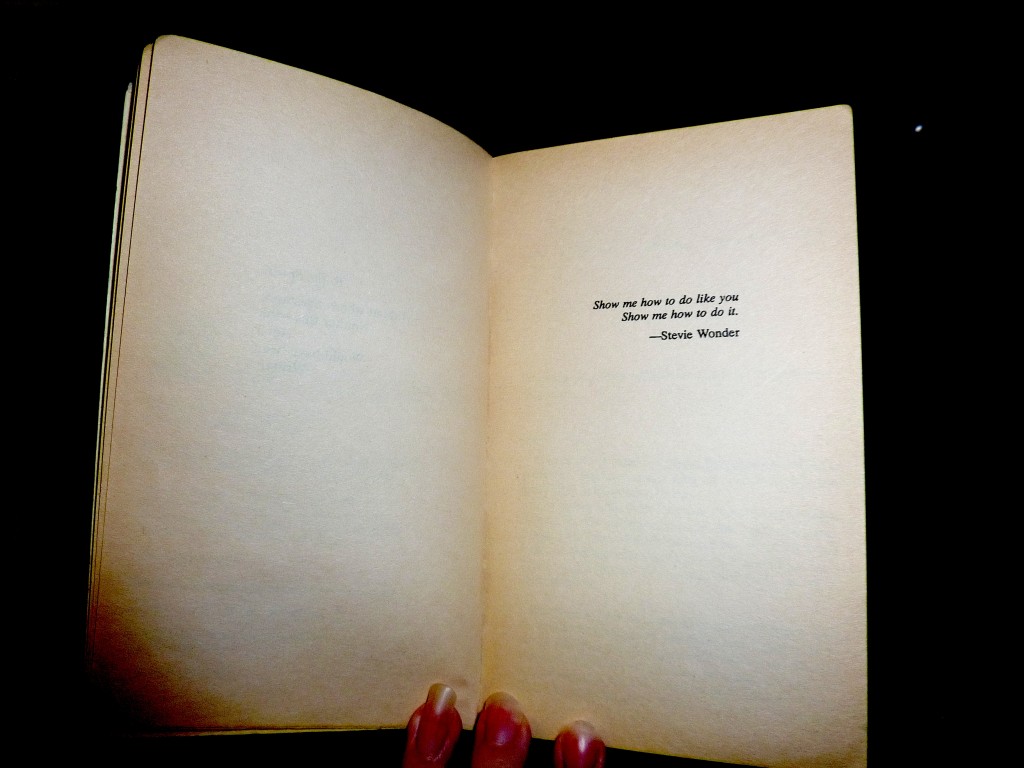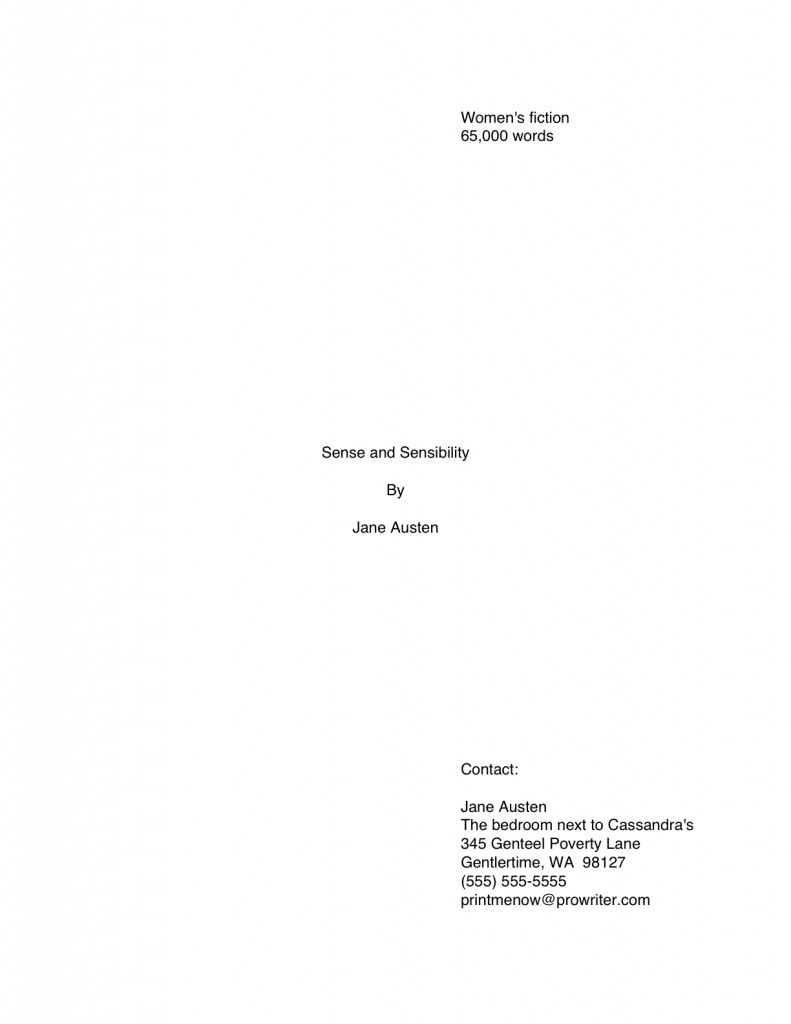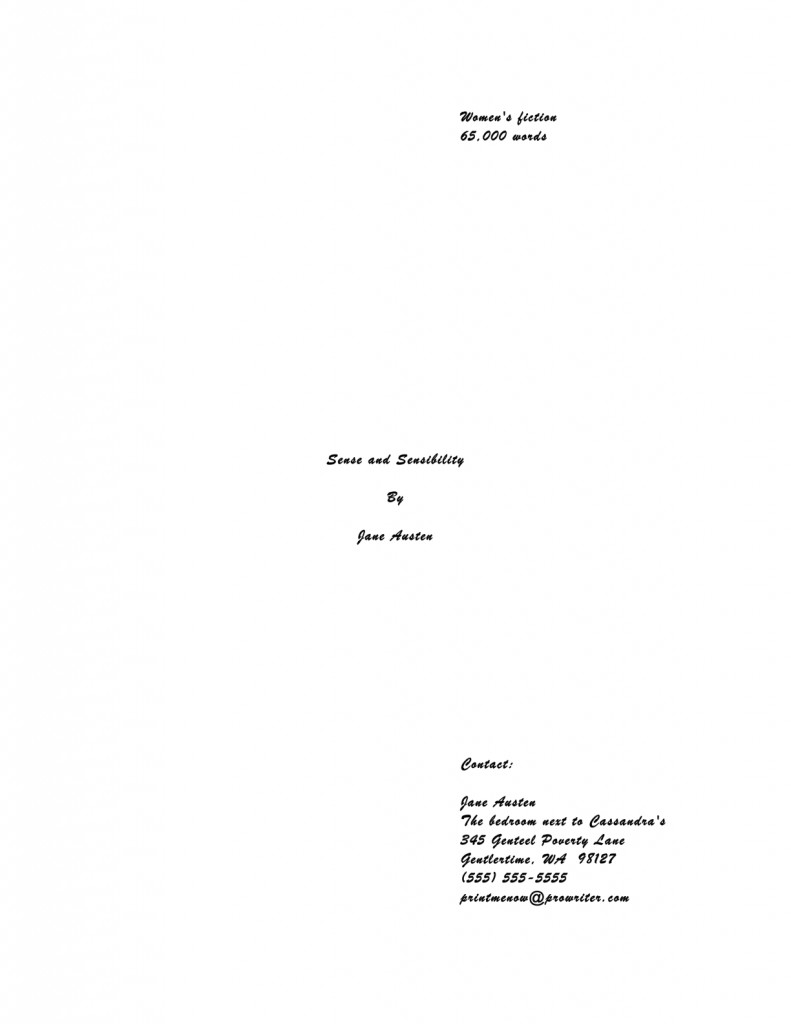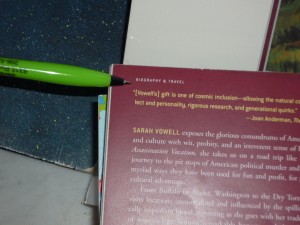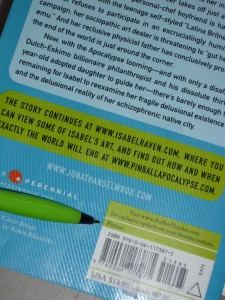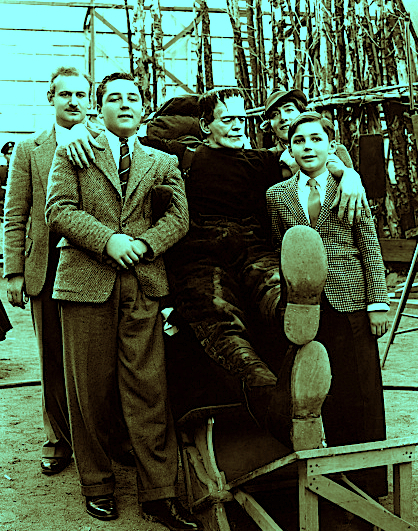
Before we delve back into the topic at hand, I’d like to point out to those of you who are not inveterate comment-readers that there has been some amazingly helpful discussion going on in the comments section of the last couple of posts, on writers’ conferences and revision, respectively. (That’s here and here, for those of you reading this on Publisher’s Marketplace.) Once commenters get chatting with one another, the discussion sometimes goes on for days, so it’s worth checking back in — and it’s definitely worth chiming in.
I just mention. And while I’m mentioning, allow me to bring up a revision-related matter inspired by one of those discussions.
All of you out there are already aware that a serious writer should never be without paper and a writing implement, right? You never know when a great idea — or turn of phrase — will hit you, after all, and every author in the world has a personal horror story about the perfect midnight inspiration that evaporated because s/he assumed, wrongly, that s/he would remember it in the morning, even if s/he didn’t write it down.
Trust me, you do not want to be like s/him. Keep a pad of paper and pen by the bed — no matter whose bed you happen to be occupying in the dead of night. (Hey, I’m here to give writing advice, not make moral judgments.)
In fact, a good writer should always assume that the only way to preserve a thought for posterity is to jot it down, NOW, before it disappears into the ether.
What does that time-honored axiom have to do with revision, you ask? It has an important corollary: don’t throw away or delete earlier versions of your manuscript; you may want to use some of that material later on. The same holds true for abandoned writing projects: that book that isn’t gelling today may well in five years.
Archiving is a writer’s friend, in short.
I’m not talking about saving a different version of your writing documents after you change each and every comma, of course. (Although while I’m tossing around helpful rules of thumb, a good writer should hit SAVE after every revised paragraph, and make back-ups frequently, unless s/he just loves trying to reconstitute a multitude of micro-changes from memory after a computer crash.) I’m talking about saving your entire manuscript before you begin revision, making a duplicate of it, and storing that duplicate — clearly labeled as DRAFT (date) — as a separate file.
That way, you can revise, comfortable in the knowledge that if you change your mind later on, you can reconstitute your earlier draft in the twinkling of an eye. Rather than, say, trying to reconstruct it from memory.
This is an especially useful strategy for writers who can’t command long stretches of revision time, instead sneaking in twenty minutes here, an hour there, as their schedule permits. It is far, far easier to recall whether you’ve completed revising Chapter 4 if your hard disk (or desk drawer, for the less technology-minded) contains documents entitled Ch 4 May 2010 and Ch 4 revision than if all you can turn up is Ch 4.
It’s also not a bad idea — and you might want to brace yourselves; this one’s quite a bit of work — to get in the habit of keeping a list of major revisions, the date you made them, and the page upon which they occurred. Not only is this an excellent way to make sure that you don’t inadvertently skip the last 10 pages of Ch 4 while you’re going through the manuscript, changing your protagonist’s boss from Edgar to Elvira; it will save you mountains of time if you subsequently decide to change it back.
“But Anne,” those of you who have been paying close attention point out, and rightly, “in that case, couldn’t I just revert to that file I clearly labeled Novel Edgar version? Wouldn’t that save me even more time?”
Well, it would, provided that in that particular revision, you had changed absolutely nothing but Edgar’s name. But come closer, and I’ll whisper a trade secret: it’s practically unheard-of for a reviser to make ONLY the intended major change. S/he’ll spot typos, for instance; the opening of the second paragraph on page 73 will suddenly seem awkward. If s/he subsequently reverts to the earlier draft, those other changes often get lost — changes that the writer in retrospect will swear that s/he made.
Because, of course, s/he did; they merely don’t show up in the older manuscript. Much head-scratching inevitably ensues.
Some of you still aren’t convinced maintaining a revision list is worth the trouble, though, are you? Okay, here’s an even better reason: if you get into the habit now, you will probably be more comfortable working with an agent or editor.
Why? Well, it’s not all that uncommon for either to request specific revisions on a manuscript, either before or after they have signed the author, or for a manuscript to go through several rounds of requested revisions. (Ideally, with the writer’s hanging on to each version in a separate computer file or hard copy, in case the agent or editor changes his/her mind.) If the revisions are minor, or — and this happens more than one might think — if the writer decides to take some revision suggestions and not others, a swiftly-skimming agent or editor might think, erroneously, that the writer simply ignored the suggestions.
Just think how much debate may be avoided if the writer can instantly whip out a list of the revisions s/he made. Or — and I personally would not dream of submitting requested submissions without this — if s/he simply tucked a cover letter listing the changes made in the box with the revised manuscript.
At minimum, such a list will render it simpler to go back and reverse specific changes, in the not-unheard-of event of the agent or editor suddenly saying, “You know, I like this version much better, but how would you feel about making Elvira male?”
Oh, you think I’m joking, do you? Tell you what: the next time you bump into me at a writers’ conference, remind me to introduce you to three or four authors to whom similar requests have been made. Or, increasingly common in recent years, authors whose editors got laid off from their publishing houses after a round of requested revisions, so the authors abruptly found themselves trying to please a new editor with completely different tastes. Trust me, these authors just LOVE to tell their revision horror stories.
Still not convinced that you should take the time to keep a revision diary? I can think of one other very solid reason to get into the habit: if you discover that you have a Frankenstein manuscript on your hands, your revision list will tell you where you should start looking for inconsistencies in the text.
Admittedly, so will reading your manuscript IN ITS ENTIRETY, IN HARD COPY, and OUT LOUD, but that takes significantly longer, at least to find a place to begin revising. Starting a revision journal and maintaining it conscientiously (hey, how much use can it be to you if you can’t trust it?) can not only help you figure out where to tackle the daunting task of revising a Frankenstein manuscript; it can prove invaluable in fending off revision-related panic (how on earth am I ever going to get through this?) and revision burnout.
For those of you just tuning in, a Frankenstein manuscript is a work that — usually inadvertently — is written (and usually revised) in so many different voices, styles, structures, and even quality of writing that it reads as though a committee had written it. Since I have literally never heard a single speaker at a writing conference address this very common problem — but have so often heard agents, editors, contest judges, writing teachers, and freelance editors complain about it in private — I wanted to alert my readers to it, lest the monster return again.
Because it will, you know. The first rule of horror is that the monster always returns. (Sort of like the mythical s/he in this post, come to think of it.)
In a way, a Frankenstein manuscript is a gift for a busy agent, editor, or judge, because it’s so very easy to reject. While I am generally very much in favor of writers doing everything they can, short of offers to do laundry or slip cash under certain doors in the dead of night, to make their agents’ and editors’ lives easier, trust me, you do not want to be on the donating end of such a gift.
Seriously, from a professional reader’s point of view, it’s no-brainer rejection if ever there was one: clearly, Millicent the agency screener thinks, if the author herself did not catch the Frankensteinish inconsistency of the text, the book needs to go through at least one more major revision.
And believe me, this needs another editing run-through is not something you want Millicent to think while considering whether to pass your submission on to her boss, the agent of your dreams. Remember, in order to reject the manuscript, all she needs to think is, “While it’s an interesting premise,” (or voice, or style, etc.) “the author needs to work on craft, structure, and consistency. We’ll catch this author next time around.”
In other words: “Next!”
Unfortunately, since Millicent usually compresses her expression of this into the standard phraseology of rejection (I’m sorry, but this manuscript does not meet our needs at this time, for instance, or I just don’t think I can place this book successfully in the current market, or the ever-popular I just didn’t fall in love with this story), the writer seldom finds out that she considers it a single revision away from being acceptable. Form-letter rejections are identical when sent to the author of a nearly-perfect manuscript and one where every third word is misspelled, after all.
In fact, agency denizens are often genuinely surprised to hear that aspiring writers with near-miss manuscripts aren’t necessarily aware of how close they are to getting accepted. Why, just last year, I asked my agent about a very talented writer I’d sent his way. He’d rejected her, and since the wording of the rejection had been rather ambiguous (along the lines of while I admire your voice, I just don’t think I can place this book successfully in the current literary market, I gather), I was curious to hear if he would be open to reading her next manuscript, a few months away from completion.
He looked at me blankly. “Next manuscript? She hasn’t dropped the first one, has she?” I assured him she had. “Oh, that’s a shame — it was really interesting. It just needed more work.”
Sound familiar? Or at any rate not surprising?
It shouldn’t be, but aspiring writers tend to overestimate, sometimes radically, the amount of time and energy an agent will be willing to invest in their first books. Think about it: every moment an agent devotes to nursing a new client’s manuscript into a publishable state is a moment that s/he is not spending selling books. Or reading the new works of clients who have already made him money. Or, perhaps closer to the hearts of agent-seekers everywhere, scanning submissions from aspiring writers.
Or having lunch with their current clients, in order to be grilled about what they thought of their friends’ submissions. Networking takes time, too, you know.
My point is, contrary to popular opinion, agencies are very seldom charitable institutions, devoted selflessly to the promotion of great literature. Even agencies that do in fact represent great literature are in the game to make money. In order to do that, they need to sell books.
Which means, in case I’ve been too subtle so far, that they’re looking for manuscripts that they not only could conceivably sell to publishing houses, but sell quickly in the current market. By definition, a manuscript that needs a whole lot of work is not going to be ready to market as soon as one that does not.
Besides, agencies receive too many letter-perfect submissions to devote much time to fixer-uppers. They figure that the fixer-uppers will come back to them eventually, anyway, all cleaned up.
Without their intervention. The average agent’s faith in the tenacity of the talented is unbounded. He honestly does believe that his dream client can figure out what to give him all by herself.
So trust me on this one: you want yours to be the submission that causes Millicent to exclaim, “Oh, this one’s ready to send out to editors right now!”
A Frankenstein manuscript is virtually never going to provoke that last exclamation, because inconsistency of voice, vocabulary, tone, etc. is a pretty sure sign that the writer has not finalized the narrative. Oh, s/he may have revised it until she’s blue in the face, but she hasn’t yet gone through the entire thing and smoothed it out so it reads like a unified story.
Here’s a word to the wise: if you are working on your first novel — or any other writing project — over the course of years, do yourself a favor and check it for stylistic consistency before you submit it to ANY agent, editor, or contest.
If you find that your voice wavers a bit throughout, don’t despair. As I mentioned last time, it’s actually quite rare that writers, even extremely gifted ones, find their specific voices right away; allow for the possibility that yours developed while you were writing the book.
Then embrace a two-part revision goal: find the voice, the style, the structure you like best, then make sure that every sentence in the book reflects it. Which, naturally, is going to be a heck of a lot easier to do if you had the forethought to keep a journal of what you changed where in the manuscript.
Without such a record, it’s quite a bit more difficult to pull off Part I of that tall order by reading your work in screen-sized chunks. In order to make absolutely sure that your book hangs together cohesively, YOU MUST READ IT IN HARD COPY.
In its entirety. Preferably in a few long sessions, and, if you change narrative voice very often, out loud, to ascertain that your various voices remain absolutely distinct throughout.
Although that last piece of advice is unlikely to come as much of a surprise to long-time readers of this blog (or even to those of you who have the attention span to remember as long ago as the opening of this post), I hear some of you grumbling out there. “But Anne,” the disgruntled protest, “I feel like I’ve been working on this book forever. I’ve revised it so often that I could recite huge chunks of it from memory. And yet you’re telling me to reread the whole thing — aloud, yet?”
Yes, I am. Actually, it may actually be more important for inveterate revisers to read their work IN HARD COPY, IN ITS ENTIRETY, and OUT LOUD.
Why, you gasp in horror? Because the more you revise a novel — or any book — the more likely it is to turn into a Frankenstein manuscript. It is an unintended downside of being conscientious about honing your craft.
Again, think about it: over time, you move passages around; you insert new scenes; you add or subtract subplots, characters, dialogue. All of these inevitably affect other parts of the book. Can you really be sure, for instance, that you remembered to remove your protagonist’s sociopathic sister from EVERY place she has ever appeared, even as a shadow on a wall?
And no, in response to what two-thirds of you just thought: merely doing a search-and-replace on the sister’s name is not sufficient, because if a novel is complex and rich, the spirit of individual characters lingers, even when they do not appear on the page. Necessarily, you would need to write the consciousness of the sociopathic sister out of the psyches of every other character in the family.
And that’s just the fall-out from a single change. The vast majority of revision is minor — which does not mean that any given change might not carry resonance throughout the book.
Starting to see why investing the time to list your revisions might conceivably be a time-saver in the long run? Or at least why I have been harping on the necessity of sitting down and reading your manuscript in its entirety, in hard copy, AND getting unbiased readers to look it over before you submit it to an agent, editor, or contest? Yes, it’s the best way to catch grammatical, spelling, and continuity errors — but it is also really the only way to notice where a deleted character or plot point still affects the rest of the book.
While you’re reading your manuscript, do be aware that It is far from uncommon for fledgling writers to incorporate the style, vocabulary, and/or worldview of whatever author they happen to be reading at the moment into their work. It’s sort of like catching an accent when you’re staying in another country: you may not realize that you’re doing it, but others hear and wonder why your accent keeps wandering back and forth between London and Brooklyn.
I’ll admit it: this used to be my personal Frankenstein bête noire. When I was writing the novel my agent is currently marketing, I was reading a whole lot of Noël Coward. An extremely witty writer; I enjoy his work very much. However, he wrote almost exclusively about (a) pre-WWII British people and (b) people who inhabited now-transformed British colonial possessions.
My novel is about the adult lives of children who grew up on an Oregon commune, so obviously, my characters should not talk like Coward’s. (Although it would have been amusing to try: “My dear, your hot tub attire is simply too killing!” “Reginald, I must implore you to desist from taunting the yoga instructor!” “May one inquire whether this tabbouleh is indeed vegan? The most frightful consequences may otherwise ensue.” “While your sincerity is charming on a multiplicity of levels, Felicia, I cannot fail to notice that you have once again neglected your duties in tending to the sauna’s controls.”)
I made a deliberate effort not to incorporate educated British cadences into my dialogue, and in self-editing, deleted any lines of thought that smacked even vaguely of 1920s urbanity. However, being a very experienced editor, I was aware that I would probably miss a few, so not only did I read the entirety of my novel out loud (much to the astonishment of my cats and neighbors), but I also passed it under the eyes of first readers I trust, with the explicit instruction that they should highlight any archaic Briticisms.
And you know what? I had missed three in my on-screen revisions, but caught in my hard-copy read-through — much to the relief, no doubt, of my highlighter-wielding friends.
My point here — other than providing some fascinating footnote material for some graduate student fifty years from now who wants to write her thesis on Noël Coward’s influence upon Gen X American novelists — is that no matter how good you get at self-editing on a page-by-page basis, in order to avoid sending out a Frankenstein manuscript, you simply must take additional steps in screening your work.
Get used to it now: you will never outgrow the need. No writer does.
Partially, it is a focus problem. In the throes of the revision process — especially on a computer screen, which encourages reading in a piecemeal, episodic fashion not conducive to catching overarching patterns — it is terribly easy to lose sight of your book AS A BOOK.
This is where a sharp-eyed writers’ group, a good writing teacher, a freelance editor, or even someone you’ve met at a writers’ conference with whom you can exchange work can be most helpful to you: assisting you in identifying what in the finished book jars with the integrity of the whole. These sources are also great for pointing out continuity errors, such as when the sociopath is named Janet for three chapters in the middle of the book, and Marie-Claire for the rest.
Not only will dependable outside eyes weed out Frankenstein tendencies, but the mere fact of having to defend your authorial choices to them will force you to make all of your deviations from standard narrative conscious, rather than accidental. Lest we forget, such discussions are also terrific practice for wrangling with your future agent and editors.
If you’re going at it alone, my advice comes in four parts.
(1) Once you have read through the whole manuscript, go back and read it again, projecting onto it the style and/or voice you like best. Does it work?
(2a) If the answer is yes, rejoice. Then skip to Step 3.
(2b) If the answer is no, pick another style or voice from the text, and project it through the entire manuscript.
(3) When you find one you like, save the original manuscript as a separate file, so you have the option of changing your mind later, and work through a separate copy, establishing the new style. In some parts, this may require extensive revision; others may need nothing but a few small tweaks.
(4) After you have finished, read the entire thing out loud again, for consistency. Does it work? More importantly, do you like it better than the original draft?
In answer to what half of you just mentally screamed: heck, yes, this is going to take you a lot of time — but few in the publishing industry would prefer to see a half-polished manuscript by a good writer, if the writer could deliver a beautifully consistent manuscript four months hence. (Unless, of course, a contract with a deadline is involved.)
Honestly, it will take you far, far less time, in both the diagnosis and repair stages, if you take your Frankenstein manuscript on a field trip to other readers before you submit it to an agent or editor. If a writing group or class seems too time-consuming, consider hiring a freelance editor; if a freelance editor seems too expensive, join a writing group.
When you are making these calculations, though, do not forget to weigh the value of your time into the equation. If attending a group once a week or paying an editor saves you a year’s worth of solo work, it might well be worth it.
Which brings me to the great question that loyal reader Pam submitted a while back: how does one FIND a freelance editor like me?
Well, Pam, as it happens, I have established a rather extensive set of posts addressing that very question. They may be found collected on the archive list at right, under the startlingly original category title HOW DO I FIND A FREELANCE EDITOR? Those posts will give you a sense of what services an editor provides (not all of us do the same thing), what to expect to pay (which varies depending upon the level of editing), and what questions you might want to ask before you sign anything that looks even remotely like a contract.
For writers in the Pacific Northwest, another great resource is the Northwest Independent Editors’ Guild’s website. For each member editor, there’s a small blurb and contact information. You can search by geographic region, the type of book you want edited, even preferred style manual, or you can post your job for editors to see.
You’re going to want either to go through an organization or get a referral to find a reputable editor, because emotionally, handing your book over to a total stranger for criticism is a difficult thing; you will want to make sure in advance that you can trust the recipient. NWIEG verifies that each member has significant editorial experience — and believe it or not, we actually do argue about punctuation on our members’ forum — so you can feel relatively secure that any editor listed will have the skills and background s/he claims s/he does.
Do take the time to have a conversation or e-mail exchange with any freelance editor before you make a commitment, however. A good personality fit is very important, and it is perfectly legitimate to ask a potential editor whether s/he has ever edited your type of book before. Just as no agent represents every variety of book under the sun, no freelance editor will have experience with every book category. While there are plenty of editors out there who are willing to take pretty much anything (for a price), working with someone who is intimately familiar with the particular demands of your book category in the current market is probably going to be more helpful to you than working with a generalist.
One final word on the subject: if you are thinking about asking a freelance editor to work on a tight deadline, do not wait until the deadline is imminent. Good freelance editors are often booked up months in advance, and if you want a careful, thoughtful, professional read, you need to allow time for the editor to do her job.
Thanks for the good question, Pam — and keep up the good work, everybody!










